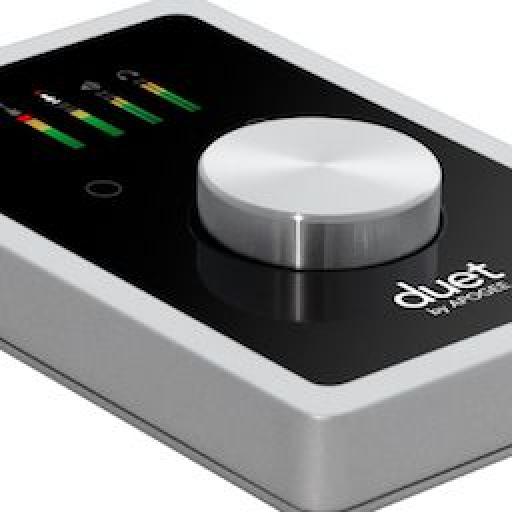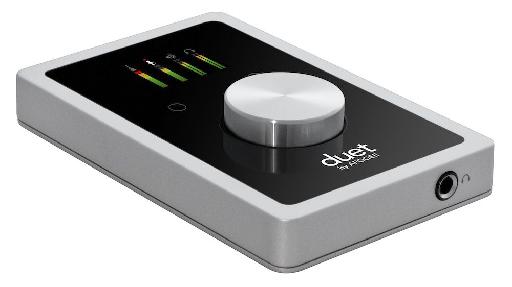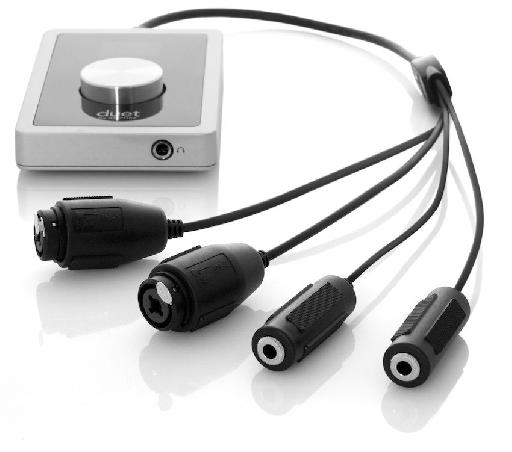Quando lançou o Apogee Duet original, a 2-in, 2-out interface de áudio, criou ondulações no mundo do áudio profissional. Junto com excelente construção, excelente qualidade de som e um preço razoável, a sua portabilidade tornou uma escolha popular para Mac baseado em músicos e audiófilos iguais. Então a grande questão, quando o Duet 2 foi anunciado, era como Apogee melhoraria na qualidade do original e manter um formato compacto e atraente.
Primeiras impressões
O Duet 2 parece lindo. Usuários de Mac vão apreciar o pôr em consideração as linhas limpas, cantos arredondados e botão multi-função única rotativo. Seu duro não amar o corpo de alumínio elegante e sexy e mais escuro faceplate do Duet 2, o que combina muito bem com o MacBook Pro e atual linha de iMac. , Bem como acrescentar estilo à sua secretária, também é um dispositivo altamente portátil. Leve o suficiente para transportar, mas forte o suficiente para levar as demandas e rigores da vida na estrada.
Get Connected
Não há drivers na caixa, por isso uma visita ao website Apogee revelou um OS X 10,7 Leão pronto para instalador que inclui o novo software de controle Maestro 2. O processo de instalação foi rápida e indolor e me deu tempo para examinar o cabo recém-projetado breakout. Apogee tomou o feedback do usuário Duet onboard em muitas áreas e este cabo reflete essa filosofia. Possui 2 combo XLR
Também em resposta ao feedback, existem 4 saídas analógicas, que são equilibrados. As saídas extra vai permitir que o Duet 2 a ser especialmente útil quando tocar ao vivo, por exemplo, ao enviar uma faixa clique para um baterista ou um mix para a frente-de-casa ou fones de ouvido.
Duet 1 proprietários podem se surpreender ao saber que este dispositivo de segunda geração é um dispositivo USB 2.0, e não Firewire. Tudo o que eu tinha acreditado sobre Firewire sendo a escolha preferida para os dados streaming, e, portanto, resultando em uma latência menor do que USB 2, parece ter se transformado em sua cabeça. De acordo com a Apogee, em um tamanho de buffer de 64 e taxa de amostragem de 44,1 kHz, o Duet 2 induz a latência de apenas 5,8 ms em comparação com o Duets 7,23 ms. E no meu mundo real (embora não científico) testes, notei uma nítida melhoria nesta área durante a gravação do Logic Pro e GarageBand.
Seu All In The Sound
Tenho vindo a utilizar o Duet original por vários anos e têm sido mais do que satisfeito com a pré-amplificadores de microfone e AD / DA conversores. Então, eu não estava à espera de perceber muito de uma melhoria na qualidade do som Duet 2s ... Eu estava, no entanto, deixou muito impressionado. O pré-amplificadores de microfone são mais limpos, mais suave e tem ganho muito mais para brincar. Eu tentei uma série de microfones de condensador e cada vez que ficou impressionada com o baixo nível de ruído e detalhe na gravação. Para gravações de palavra falada que eu precisava para aplicar muito pouco, se houver, corretiva EQ para trazer a voz.
A qualidade do som geral do Duet 2 bate facilmente dispositivos semelhantes dentro de sua faixa de preço, e mesmo aqueles custar duas a três vezes mais. Ele fornece o tipo de resultados sonoros youd esperar do Symphony Apogee.
Mais controle
Além da bela display OLED (que faz monitoramento e gravação longe de sua tela mais fácil), há agora dois touchpads acima do botão controlador multi-função. Ambos podem ser atribuídos ao usuário dentro Maestro 2. Eu pessoalmente achei excelente para ter Sum para Mono e Fonte Headphone Alternar atribuído um dia, e saídas, em seguida, Dim e Medidores claras para outro projeto. Todas as funções principais que você precisa acessar podem ser controlados directamente a partir do touchpads ou o botão controlador de hardware, com exceção de alternar a alimentação fantasma ou escolher o tipo de entrada que deve ser configurado no Maestro 2.

Conclusão
Apogee é conhecida por criar produtos que são ambos muito bem desenhados e apresentam pura qualidade de som para a multidão de áudio profissional. O Duet 2 continua essa tradição com a sua pré-amplificadores de microfone excelente, baixa latência, saídas extra, ecrã a cores, e interface de toque designáveis. Qualquer músico Mac considerando um novo 2-in e 4-out interface (24 bits e até 192kHz) vai encontrar o Duet 2 uma excelente escolha. E proprietários Duet existentes também vai encontrar esses recursos extras, razões muito convincentes para atualizar.





 © 2024 Ask.Audio
A NonLinear Educating Company
© 2024 Ask.Audio
A NonLinear Educating Company
Discussion
Apogee support was not helpful and the whole experience (especially after contacting support) left me disinclined to purchase another Apogee product.
Some people have reported problems with the cable harness (there is at least one third party replacement that is better if you want to spend the money), however the harness was not the cause of my problems.
Maybe they've improved the Duet 2, but I recommend looking at other options first.
I haven't had any bad experiences with my Duet v.1. But, I have to say, having spoken to some of the people at Apogee, that the Duet 2 has been completely redesigned.
Sorry to hear you had bad experiences at all... though I'd still recommend checking out the Duet 2. It is simply awesome!
Best
Rounik
What's the preferred way to setup gain levels on the mic settings on Duet 2 when working with tools such as garageband. It comes out the levels are either too low or too high (clips). There are 2 places one can configure: on duet2 and the software. Type of music is softer Indian period music with few graduated high notes. As you can see I'm a novice.
Thanks!
Jay
When recording audio through a device like the Duet 2 into software which supports 24-bit depth you don't need to record at a very high level. Basically, never ever let the signal clip (go into the red). Clipping will cause distortion which you certainly don't want.
If the recorded level is low then either re-position the microphone to suit, or once recorded increase the level of the volume using a gain plug-in.
Most professional recording engineers record electric or acoustic sources between -18 to -12dB. This gives plenty of headroom (the space between your recorded level and 0dB - where the audio signal will begin to clip).
I'd highly recommend watching this tutorial on basic recording techniques:
http://www.macprovideo.com/tutorial/introduction-to-recording
There's so much good info there which will help you now and as you gain more experience.
In essence, with the current audio hardware and software, there's no need to record so the level hits 0dB. You can record at a lower level and boost the gain later on in the process.
Hope this helps,
Rounik
Want to join the discussion?
Create an account or login to get started!